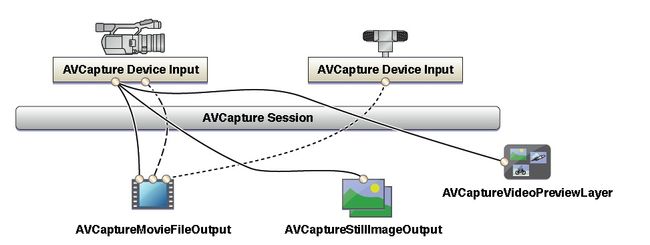ios学习--camera capture
1,ACCaptureSession:
用于组织Device,input和output之间的连接,类似于DShow的filter的连接。如果能够将input和output连接,则在start之后,数据将冲input输入到output。
主要的几个点:
a)ACCaptureDevice 用于设备的定义,既camera device。
b)AVCaptureInput
c)AVCaptureOutput
输入和输出都不是一对一的,如video output可以同时又video+audio的input。
切换前后摄像头:
AVCaptureSession *session = <#A capture session#>;
[session beginConfiguration];
[session removeInput:frontFacingCameraDeviceInput];
[session addInput:backFacingCameraDeviceInput];
[session commitConfiguration];
添加capture input:
To add a capture device to a capture session, you use an instance of AVCaptureDeviceInput (a concrete
subclass of the abstract AVCaptureInput class). The capture device input manages the device’s ports.
NSError *error = nil;
AVCaptureDeviceInput *input =
[AVCaptureDeviceInput deviceInputWithDevice:device error:&error];
if (!input) {
// Handle the error appropriately.
}
添加output,output的分类:
To get output from a capture session, you add one or more outputs. An output is an instance of a concrete
subclass of AVCaptureOutput; you use:
● AVCaptureMovieFileOutput to output to a movie file
● AVCaptureVideoDataOutput if you want to process frames from the video being captured
● AVCaptureAudioDataOutput if you want to process the audio data being captured
● AVCaptureStillImageOutput if you want to capture still images with accompanying metadata
You add outputs to a capture session using addOutput:. You check whether a capture output is compatible
with an existing session using canAddOutput:. You can add and remove outputs as you want while the
session is running.
AVCaptureSession *captureSession = <#Get a capture session#>;
AVCaptureMovieFileOutput *movieInput = <#Create and configure a movie output#>;
if ([captureSession canAddOutput:movieInput]) {
[captureSession addOutput:movieInput];
}
else {
// Handle the failure.
}
保存一个video文件,既添加video file output:
You save movie data to a file using an AVCaptureMovieFileOutputobject. (AVCaptureMovieFileOutput
is a concrete subclass of AVCaptureFileOutput, which defines much of the basic behavior.) You can configure
various aspects of the movie file output, such as the maximum duration of the recording, or the maximum file
size. You can also prohibit recording if there is less than a given amount of disk space left.
AVCaptureMovieFileOutput *aMovieFileOutput = [[AVCaptureMovieFileOutput alloc]
init];
CMTime maxDuration = <#Create a CMTime to represent the maximum duration#>;
aMovieFileOutput.maxRecordedDuration = maxDuration;
aMovieFileOutput.minFreeDiskSpaceLimit = <#An appropriate minimum given the quality
of the movie format and the duration#>;
处理preview video frame数据,既每一帧的view finder数据,可以用于后续的一些高级处理,如人脸检测等等:
An AVCaptureVideoDataOutput object uses delegation to vend video frames. You set the delegate using
setSampleBufferDelegate:queue:. In addition to the delegate, you specify a serial queue on which they
delegate methods are invoked. You must use a serial queue to ensure that frames are delivered to the delegate
in the proper order. You should not pass the queue returned by dispatch_get_current_queue since there
is no guarantee as to which thread the current queue is running on. You can use the queue to modify the
priority given to delivering and processing the video frames.
对于frame数据的处理,必须有大小的限制(image size)和处理时间的限制,如果处理了时间过长,则底层sensor将不会送数据给layouter和这个回调。
You should set the session output to the lowest practical resolution for your application. Setting the output
to a higher resolution than necessary wastes processing cycles and needlessly consumes power.
You must ensure that your implementation of
captureOutput:didOutputSampleBuffer:fromConnection: is able to process a sample buffer within
the amount of time allotted to a frame. If it takes too long, and you hold onto the video frames, AV Foundation
will stop delivering frames, not only to your delegate but also other outputs such as a preview layer.
处理capture的流程:
AVCaptureStillImageOutput *stillImageOutput = [[AVCaptureStillImageOutput alloc]
init];
NSDictionary *outputSettings = [[NSDictionary alloc] initWithObjectsAndKeys:AVVideoCodecJPEG,
AVVideoCodecKey, nil];
[stillImageOutput setOutputSettings:outputSettings];
能够支持不同的format,也支持直接生成jpg流。
If you want to capture a JPEG image, you should typically not specify your own compression format. Instead,
you should let the still image output do the compression for you, since its compression is hardware-accelerated.
If you need a data representation of the image, you can use jpegStillImageNSDataRepresentation: to
get an NSData object without re-compressing the data, even if you modify the image’s metadata.
Camera preview显示:
You can provide the user with a preview of what’s being recorded using an AVCaptureVideoPreviewLayer
object. AVCaptureVideoPreviewLayer is a subclass ofCALayer (see Core Animation Programming Guide .
You don’t need any outputs to show the preview.
AVCaptureSession *captureSession = <#Get a capture session#>;
CALayer *viewLayer = <#Get a layer from the view in which you want to present the
preview#>;
AVCaptureVideoPreviewLayer *captureVideoPreviewLayer = [[AVCaptureVideoPreviewLayer
alloc] initWithSession:captureSession];
[viewLayer addSublayer:captureVideoPreviewLayer];
In general, the preview layer behaves like any other CALayer object in the render tree (see Core Animation
Programming Guide ). You can scale the image and perform transformations, rotations and so on just as you
would any layer. One difference is that you may need to set the layer’s orientation property to specify how
it should rotate images coming from the camera. In addition, on iPhone 4 the preview layer supports mirroring
(this is the default when previewing the front-facing camera).

